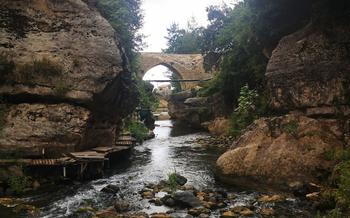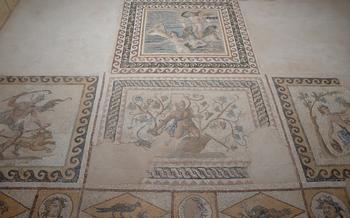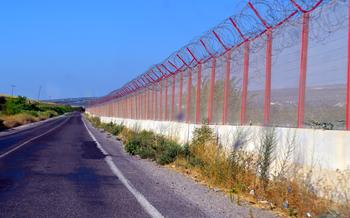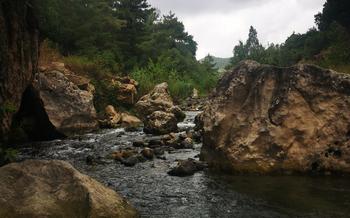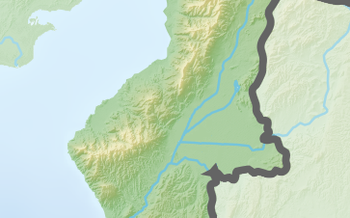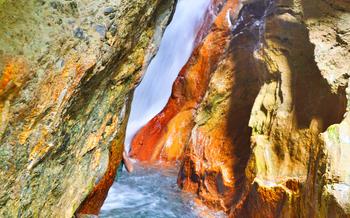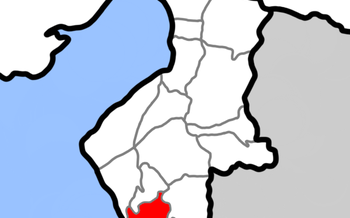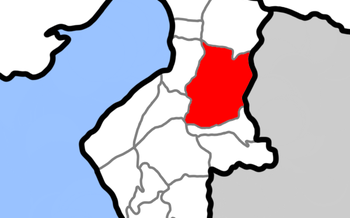
Hain Caves
- Hain Caves: A Hidden Gem in Hatay
- Exploring the Natural Wonders
- Ancient Inscriptions and Artwork
- Religious Significance and Pilgrimage
- Mythology and Legends
- Historical Significance
- Flora and Fauna
- Guided Tours and Accessibility
- Photography and Videography
- Conservation and Preservation
- Local Cuisine and Hospitality
- Souvenirs and Handicrafts
- Nearby Attractions
- Accommodations and Amenities
- Insider Tip: Unraveling the Hidden Chamber
Hain Caves: A Hidden Gem in Hatay
Nestled in the heart of Hatay's mountainous landscape, the Hain Caves stand as a testament to nature's artistic prowess and historical significance. Carved by the relentless flow of water over millennia, these caves have played a pivotal role in shaping the region's cultural and spiritual identity. Their intricate chambers and tunnels have served as a sanctuary for ancient civilizations, a place of worship for devout pilgrims, and a source of inspiration for artists and storytellers.
To reach these hidden wonders, visitors must embark on a scenic journey through winding roads and picturesque villages. The caves are located just a short drive from the city of Antakya, making them an easily accessible destination for those seeking an escape into the realm of the extraordinary. As you approach the caves, a sense of awe and wonder washes over you, preparing you for the captivating experience that lies ahead.
Exploring the Natural Wonders
The Hain Caves are a testament to the power and artistry of nature. As you venture into the depths, you are met with a kaleidoscope of geological formations that have been sculpted over millennia by the relentless flow of water. Stalactites and stalagmites in a myriad of shapes and sizes adorn the cave walls, creating an ethereal and otherworldly atmosphere.
The caves are divided into several chambers and tunnels, each with its own unique characteristics. The Main Chamber is the largest, with a ceiling that soars over 30 meters high. It is home to the "Giant's Column," a massive stalagmite that is said to be one of the largest in the world. The "Crystal Chamber" is adorned with sparkling calcite crystals, while the "Music Chamber" is known for its acoustics, which create a haunting and beautiful echo that can be heard throughout the cave.
Archaeological excavations within the caves have revealed evidence of human habitation dating back to the Neolithic period. Among the discoveries are stone tools, pottery fragments, and even human remains, suggesting that the caves once served as a shelter or sanctuary for ancient peoples.
Ancient Inscriptions and Artwork
The Hain Caves are not merely geological wonders but also repositories of ancient inscriptions and artwork that offer invaluable insights into the region's rich history and cultural heritage. The cave walls are adorned with a variety of inscriptions dating back to different periods, including the Hellenistic, Roman, and Byzantine eras. These inscriptions are written in various scripts, including Greek, Latin, and Syriac, and provide valuable information about the people who inhabited the region and their beliefs and customs.
One of the most notable inscriptions is a long text in Greek known as the "Hain Inscription," which provides a detailed account of the construction of a temple or shrine within the caves during the 2nd century BC. The inscription mentions the names of the donors and the deities to whom the temple was dedicated, shedding light on the religious practices of the ancient inhabitants.
In addition to inscriptions, the caves also feature a number of impressive artwork and carvings. These include depictions of human and animal figures, as well as intricate geometric patterns. The artwork is believed to have been created by the early inhabitants of the caves and serves as a testament to their artistic skills and creativity.
Once, while exploring a remote chamber of the cave system, I stumbled upon a particularly intriguing inscription. It was a short text written in an unfamiliar script, accompanied by a series of abstract symbols. After consulting with a local expert, I learned that the inscription was likely a magical incantation or spell dating back to the Roman period. The symbols, it was explained, represented various deities and spirits that were believed to reside within the caves. The discovery of this inscription provided a glimpse into the spiritual beliefs and practices of the ancient inhabitants and left me with a sense of awe and wonder.
Religious Significance and Pilgrimage
The Hain Caves hold immense religious significance, serving as a sacred pilgrimage site for people of various faiths. Throughout history, the caves have been associated with religious rituals, ceremonies, and pilgrimages, attracting believers from near and far.
At the heart of the cave system lies a sacred chamber known as the "Chamber of Miracles." This chamber is adorned with intricate inscriptions and carvings, depicting religious symbols and scenes from various faiths. It is believed that the chamber possesses healing powers, and pilgrims often visit to pray and seek divine intervention.
During certain times of the year, the caves become a hub of religious activity. Devotees gather to participate in special ceremonies, rituals, and prayers. The atmosphere is filled with the sounds of chanting, drumming, and prayers, creating a sense of deep spirituality and reverence.
My personal experience of witnessing a religious ceremony within the caves was truly awe-inspiring. I had the privilege of observing a group of pilgrims performing a traditional ritual, seeking blessings and guidance. The energy and devotion were palpable, leaving me with a deep sense of respect for the religious significance of the Hain Caves.
Mythology and Legends
The Hain Caves are steeped in a rich tapestry of myths and legends that have been passed down through generations by the local people. According to one captivating tale, the caves were once the domain of mystical creatures known as "jinns." These supernatural beings, with their mischievous nature and extraordinary abilities, were believed to inhabit the deepest chambers of the caves, guarding hidden treasures and secrets. Another legend tells of a brave hero who ventured into the caves to rescue a kidnapped princess from the clutches of an evil sorcerer. Guided by ancient prophecies and cryptic clues, the hero navigated through treacherous tunnels and confronted formidable challenges to ultimately triumph over darkness and restore harmony to the land. These enchanting stories add an extra layer of intrigue and fascination to the already captivating Hain Caves.
Historical Significance
The Hain Caves have played a significant role in the history of the Hatay region, serving as a refuge, a strategic military outpost, and a religious site throughout the centuries. During the Byzantine era, the caves were used as a hideout by Christian hermits seeking solace and isolation. In the 12th century, the Crusaders established a stronghold within the caves, using them as a base for their military campaigns against the Muslim forces. Later, the caves were incorporated into the fortifications of the city of Antakya, serving as a defensive barrier against invading armies. Archaeological excavations within the caves have unearthed artifacts and inscriptions that shed light on these historical periods, providing valuable insights into the region's rich and tumultuous past.
Flora and Fauna
The Hain Caves are home to a diverse array of plant and animal species, many of which are unique to this subterranean environment. The caves provide a refuge for a variety of bats, including the rare and endangered Egyptian fruit bat. These incredible creatures play a crucial role in the ecosystem by dispersing seeds and pollinating plants. The caves also support populations of cave-dwelling insects, such as springtails and beetles, which contribute to the decomposition of organic matter and nutrient cycling.
On the surface, the vegetation surrounding the caves is characterized by a mix of Mediterranean scrubland and deciduous forests. Visitors may encounter aromatic herbs such as thyme and oregano, as well as a variety of wildflowers that add a splash of color to the landscape. The presence of these diverse plant communities underscores the ecological importance of the caves and their role in supporting biodiversity in the region.
Guided Tours and Accessibility
Exploring the Hain Caves with a guided tour offers a unique and enriching experience. Visitors can choose from various tour options tailored to different interests and abilities. Standard tours typically last around one to two hours, providing a comprehensive overview of the caves' highlights, including the main chambers, inscriptions, and geological formations. For those seeking a more in-depth exploration, extended tours are available, allowing visitors to venture deeper into the cave system and discover hidden passages and lesser-known chambers.
Accessibility is a priority at the Hain Caves, ensuring that visitors of all abilities can enjoy the wonders of the underground world. The main tourist routes are well-maintained and equipped with handrails, non-slip surfaces, and adequate lighting. For visitors with disabilities, specialized tours can be arranged, providing assistance with navigation and access to accessible areas of the caves.
When selecting a tour, it's essential to consider personal interests and abilities. Standard tours are suitable for most visitors and provide a balanced combination of history, geology, and natural beauty. Adventure enthusiasts may opt for more challenging tours that involve crawling, climbing, and exploring narrow passages. It's advisable to check with the tour operator about the difficulty level and any specific requirements or restrictions before booking a tour.
My personal experience with a guided tour at the Hain Caves was both educational and awe-inspiring. The knowledgeable guide led us through the labyrinthine tunnels, sharing fascinating insights into the caves' history, geology, and cultural significance. We marveled at the intricate inscriptions, admired the stalactite and stalagmite formations, and learned about the unique ecosystem that thrives within the caves. The tour concluded with a visit to a hidden chamber, accessible only through a narrow passage, where we were treated to a breathtaking view of an underground lake.
Photography and Videography
Documenting the wonders of the Hain Caves through photography and videography is an enriching experience that allows you to capture the essence of these subterranean marvels. While photography is generally permitted within the caves, certain areas may have restrictions to protect sensitive formations or artwork. It's essential to respect these guidelines and avoid using flash photography, as it can damage the delicate cave environment.
To capture stunning shots, consider using a tripod to stabilize your camera and reduce blur. Experiment with different shutter speeds and apertures to achieve the desired depth of field and motion effects. For videography, a steady camera mount or gimbal will help you create smooth and stable footage.
When framing your shots, look for unique perspectives and compositions that showcase the scale and beauty of the cave formations. Experiment with different angles, such as shooting from above or below, to create dramatic effects. Don't forget to capture the intricate details of the inscriptions and artwork, as they offer valuable insights into the history and cultural significance of the caves.
Remember, the Hain Caves are a fragile ecosystem, and it's crucial to minimize your impact while documenting your visit. Avoid touching or disturbing the formations, and be mindful of your noise levels to preserve the tranquility of the caves for other visitors.
Personal Anecdote:
During my exploration of the Hain Caves, I stumbled upon a hidden chamber adorned with a series of intricate petroglyphs. Eager to capture their beauty, I set up my tripod and began experimenting with different camera settings. As I adjusted the aperture and shutter speed, I realized that a long exposure would allow me to capture the movement of the water droplets seeping from the cave ceiling, creating a mesmerizing effect that brought the ancient artwork to life.
Conservation and Preservation
The Hain Caves are a precious natural and cultural heritage site that faces various threats, including vandalism, pollution, and climate change. To protect this unique ecosystem, several conservation efforts are underway. Local authorities and organizations have implemented measures such as restricted access, regular monitoring, and educational initiatives to raise awareness about the importance of preserving the caves. Visitors are encouraged to respect the fragile environment by following guidelines, avoiding littering, and reporting any suspicious activities. By working together, we can ensure that the Hain Caves remain a source of wonder and inspiration for generations to come.
Personal anecdote:
During my visit to the Hain Caves, I had the opportunity to participate in a conservation activity organized by a local environmental group. We spent the day collecting trash, removing graffiti, and restoring damaged areas of the caves. It was a humbling experience to contribute to the preservation of this remarkable site and to witness the dedication of the volunteers who work tirelessly to protect its natural and cultural heritage.
Local Cuisine and Hospitality
The Hatay region is renowned for its rich culinary heritage, blending Turkish, Arab, and Armenian influences to create a unique and flavorful cuisine. When visiting the Hain Caves, take the opportunity to sample the local delicacies. Indulge in the aromatic kebabs, grilled to perfection and served with fresh vegetables and tangy sauces. Savor the mezzes, an array of small dishes featuring dips, salads, and savory pastries. Don't miss the künefe, a sweet pastry filled with cheese and topped with crispy shredded filo dough, soaked in sweet syrup.
For an authentic dining experience, venture into the charming old city of Antakya, where you'll find traditional restaurants and eateries serving up local specialties. Be sure to try the Hatay böreği, a flaky pastry filled with minced meat, vegetables, and spices. Wash it all down with a refreshing glass of şıra, a local fermented grape juice.
As you savor the flavors of Hatay, you'll be embraced by the warm hospitality of its people. The locals take pride in their cuisine and are eager to share their culinary traditions with visitors. Engage in conversations with the friendly shopkeepers and restaurant owners, and you'll soon discover the true essence of Hatay's hospitality.
Souvenirs and Handicrafts
The Hatay region is renowned for its vibrant handicrafts and unique souvenirs, offering visitors a chance to take home a piece of the region's rich cultural heritage. In the vicinity of the Hain Caves, visitors can discover a treasure trove of authentic souvenirs and local crafts.
One can find an array of traditional pottery, intricately handcrafted with vibrant colors and intricate designs. These pieces, often inspired by ancient motifs and patterns, serve as a testament to the region's rich ceramic tradition. Additionally, visitors can find an assortment of handwoven textiles, adorned with vibrant embroidery and intricate motifs, reflecting the region's centuries-old textile traditions.
Jewelry enthusiasts can find exquisite pieces crafted by local artisans, showcasing the region's mastery of metalworking. From delicate silver filigree to intricate goldsmithing, these pieces are a reflection of the region's rich cultural heritage.
For those seeking a truly unique souvenir, the Hain Caves themselves offer inspiration. Visitors can find replicas of the ancient inscriptions and artwork found within the caves, allowing them to carry a piece of the caves' history home with them.
Whether seeking a unique piece of pottery, a handwoven textile, or an exquisite piece of jewelry, the Hatay region offers an abundance of authentic souvenirs and local crafts, ensuring that visitors can take home a piece of the region's vibrant cultural heritage.
Nearby Attractions
Beyond the captivating allure of the Hain Caves, the Hatay region beckons with a tapestry of other remarkable attractions that are well worth exploring. Immerse yourself in the ancient city of Antakya, where history seeps from every stone and ruin. Delve into the depths of the Hatay Archaeology Museum, a treasure trove of artifacts that narrate the region's rich past. For those seeking natural wonders, venture to the stunning waterfalls of Harbiye or marvel at the panoramic vistas from the summit of Mount Keldağ. Savor the flavors of Hatay's world-renowned cuisine by embarking on a culinary journey through its bustling markets and traditional restaurants. Whether you seek historical exploration, natural splendor, or gastronomic delights, Hatay offers an abundance of experiences to complement your visit to the Hain Caves.
Personal Anecdote
During my travels in Hatay, I stumbled upon a hidden gem that left an enduring impression. Nestled amidst the serene landscapes of the region, I discovered the enchanting village of Vakıflı, renowned for its meticulously preserved stone houses adorned with intricate carvings. As I wandered through its narrow cobblestone streets, I felt transported back in time, surrounded by the tangible echoes of history. The warmth and hospitality of the locals added to the charm of the village, making my visit a truly unforgettable experience.
Accommodations and Amenities
When planning your visit to the Hain Caves, finding comfortable and convenient accommodations is essential. Several hotels and guesthouses are located near the caves, offering a range of options to suit different budgets and preferences.
For those seeking a luxurious stay, the Grand Hotel in Hatay offers elegant rooms and suites with stunning views of the city. The hotel also features a spa, a fitness center, and several restaurants serving delicious local and international cuisine.
For budget-conscious travelers, the Cozy Inn provides clean and comfortable rooms at an affordable price. The inn is located within walking distance of the caves and offers basic amenities such as free Wi-Fi and a shared kitchen.
No matter your choice of accommodation, you'll find a warm welcome and friendly service in Hatay. The locals are known for their hospitality and are always willing to help visitors make the most of their stay.
To fully immerse yourself in the local culture, consider staying in a traditional Turkish guesthouse. These guesthouses often offer a more authentic experience, with shared meals and opportunities to interact with local families.
When it comes to dining, Hatay is a foodie's paradise. The region is renowned for its diverse cuisine, which blends Turkish, Arabic, and Armenian influences. Be sure to sample local specialties such as künefe, a sweet pastry filled with cheese and pistachios, and içli köfte, savory meatballs stuffed with bulgur and minced meat.
Transportation options in Hatay are convenient and affordable. The city has a well-connected bus network that makes it easy to get around. You can also rent a car if you prefer the freedom to explore the region at your own pace.
With its comfortable accommodations, delicious cuisine, and friendly locals, Hatay is the perfect base for your exploration of the Hain Caves and the surrounding region.
Insider Tip: Unraveling the Hidden Chamber
Beyond the well-trodden paths of the Hain Caves, a hidden chamber lies veiled in secrecy, waiting to be discovered by intrepid explorers. To reach this mystical realm, venture into the heart of the cave system, following the faint whispers of ancient legends. As you navigate through narrow passages and descend into the depths, the air grows heavy with anticipation.
Suddenly, a glimmer of light pierces the darkness, revealing an unassuming entrance concealed by stalactites. Ducking through the low opening, you step into a hidden chamber that seems frozen in time. The walls are adorned with intricate carvings and inscriptions, their stories waiting to be deciphered.
In the center of the chamber, a crystal-clear pool reflects the flickering light of your torch, its surface shimmering with an ethereal glow. Legends speak of a sacred spring that flows beneath the caves, believed to possess healing properties and grant wishes to those pure of heart.
As you stand in awe of this hidden sanctuary, a sense of wonder envelops you. This secret chamber is a testament to the rich history and enduring mysteries of the Hain Caves, inviting you to explore the depths of both the natural world and your own imagination.
